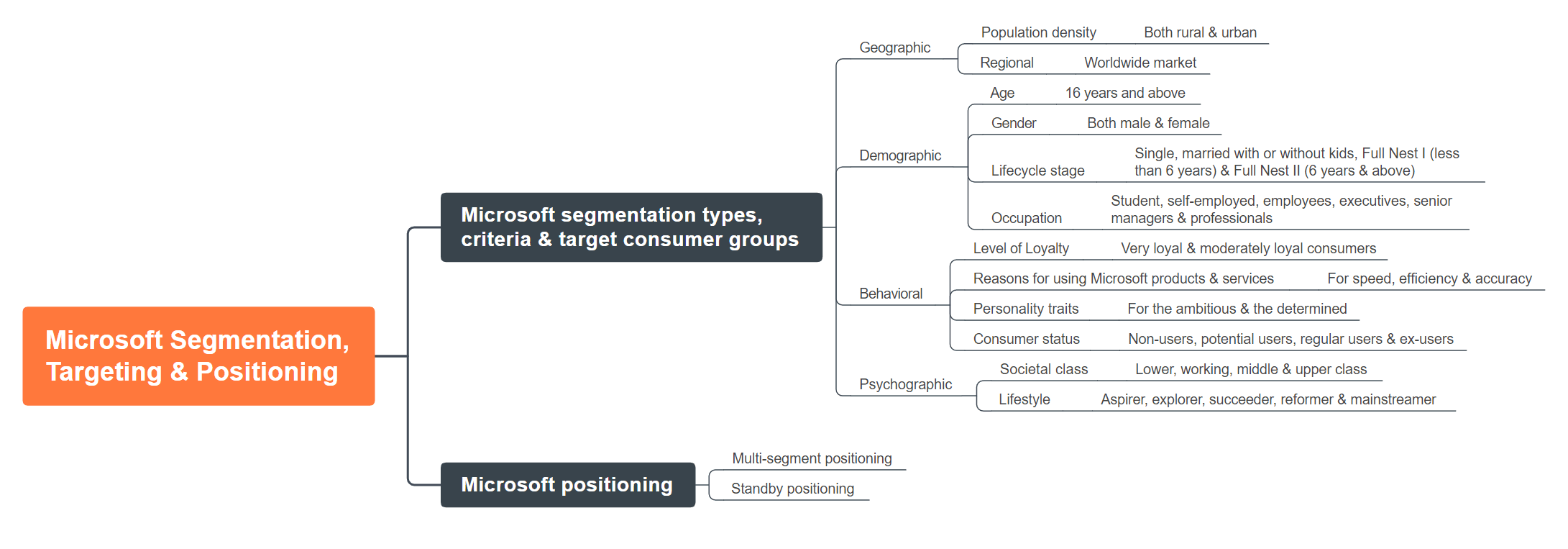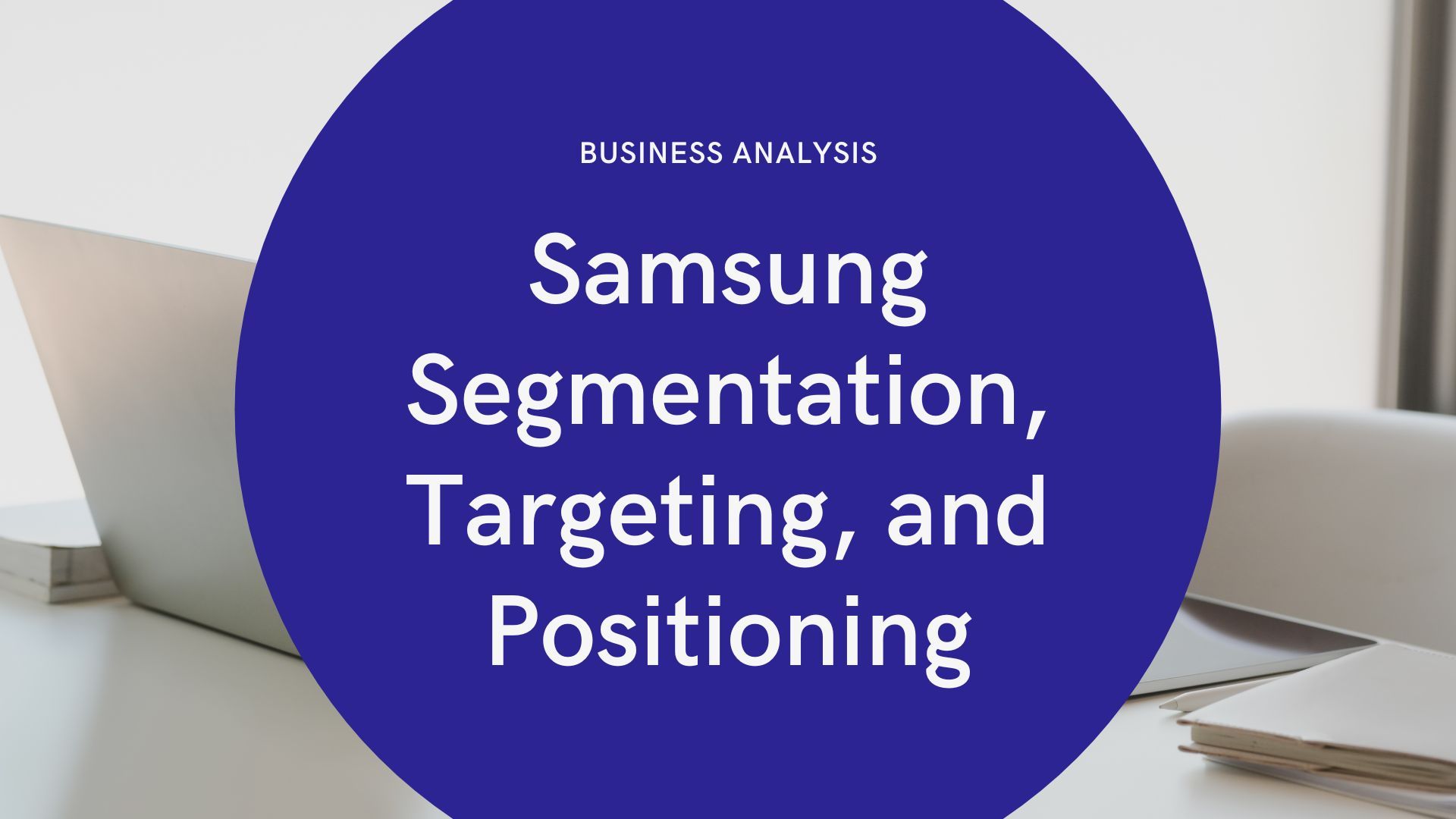Introduction
Microsoft probably needs no introduction, as it is arguably the most renowned technological brand the world has ever known. This company was established in Albuquerque, New Mexico, the USA, by both Paul Allen and Bill Gates way back in 1975. In the last 46 years, Microsoft has churned out innovative products, including operating systems for personal computers.
As a matter of fact, Microsoft is a global leader in the conceptualization, design, and launching of highly compatible operating systems. By 2020, Microsoft would be ranked at #21 among the most important corporations in the US in the illustrious Fortune 500 rankings. However, the steady rise of this information technology (IT) company can be linked to its market segmentation, targeting, and positioning efforts.
Market Segmentation of Microsoft
Microsoft segmentation is a strategy deployed by the company to break up the US and indeed the global population into different segments or groups. The purpose of this is to identify those segments that best fit Microsoft's proposed target audience. This target consumer group is identified by virtue of different segmentation types, namely; Geographic, Demographic, Behavioral, and Psychographic.
Microsoft examines the wants and needs of these segments and then sees how they can realistically provide or meet the prevailing product and service demands of each segment. Each group offers certain criteria; for example, Geographic segmentation involves population density and specific regions. Demographic segmentation involves criteria such as; Age, Gender, Life-cycle stage, and Occupation.
For Behavioral segmentation, Microsoft focuses on the Level of Consumer Loyalty, their reasons for using Microsoft products, their Personality Traits, and user Status. For the Psychographic type of segmentation, the criteria Microsoft looks at include the Lifestyle and Social Class of prospective consumers.
Targeting of Microsoft
Microsoft's slogan is "Your potential, our passion." Therefore, this company is dedicated to providing innovative IT products that would enable its customers to achieve their goals in whatever field of endeavor they may be in. Microsoft's target market is broad-based and can be found in the various types of segmentation highlighted. For example, under Geographic segmentation, Microsoft's target consumer groups include customers on a global scale located in both rural and urban areas.
Microsoft also offers products for male and female target audiences from 16 years old and above. This includes students, self-employed individuals, employees, and professionals. What's more, Microsoft products and services consumers cut across all social classes and lifestyles.
Positioning of Microsoft
Microsoft positioning can be broken down into two main types, namely;
- Multi-segment positioning and
- Standby positioning.
With Multi-segment positioning, Microsoft focuses on simultaneously targeting multiple consumer groups. This is done by providing a variety of IT products and services at any one time. The products and services are produced for the here and now. The products and services are designed to satisfy the current demand in the IT market. One notable example of Microsoft's Multi-segment positioning has to do with its Dynamics 365 software.
This software application was designed to assist businesses in their bid to build and support customer relationships. Dynamic 365 is priced at USD$115 per month for the 'Customer Engagement Plan.' This plan is designed for the price-sensitive consumer segment.
The Dynamics 365 software also has another plan simply known as the 'Unified Operations Plan.' This customer plan costs a minimum of USD$190 per month. However, this plan is not meant for price-sensitive consumers but rather for that consumer group that will not be too bothered about paying a little extra in order to activate more features and functions within the software.
On the other hand, with Standby positioning, Microsoft produces a range of products to meet possible future demands. These demands may be from currently identified Microsoft target market groups or segments likely to emerge from existing or new markets.
The cloud data storage segment was an emerging market back in 2014. Microsoft anticipated the long-term significance of this segment. They immediately launched their 'cloud-first, mobile-first marketing strategy in the same year. Ultimately, Microsoft put its Standby positioning strategy to full use by developing a series of cloud-based products and services ahead of time. This was done in anticipation of the huge demand for cloud data storage by a fast-emerging new segment.
Over time, this strategy has proven to be successful for Microsoft, as seen in its revenue figures from the sale of cloud-based products and services. In 2018, Microsoft recorded revenue figures from the sale of cloud products in excess of USD$6.5 billion in just the second quarter of the year. This represented an outstanding growth in revenue by as much as 53%, which was a significant rise compared to the previous financial year.
Therefore, standby positioning is a sort of anticipatory type of positioning where Microsoft envisages that certain innovative products would receive a greater demand in the distant or not too distant future. In other words, the products and services may not be ripe for demand at this present point in time, but the potential for a breakthrough later on in the future is highly possible.
So by adopting the standby positioning strategy, Microsoft positions its brand, product, and services in such a way that it takes full advantage of the windfall that arises from the emergence of a new segment and the possibility of that particular segment being profitable in the long-run.
Table - Microsoft Segmentation, Targeting, and Positioning Illustrated
| MICROSOFT SEGMENTATION TYPES | CRITERIA FOR SEGMENTATION | MICROSOFT TARGET CONSUMER GROUP |
| GEOGRAPHIC | POPULATION DENSITY | BOTH RURAL & URBAN |
| REGIONAL | WORLDWIDE MARKET | |
| DEMOGRAPHIC | AGE | 16 YEARS AND ABOVE |
| GENDER | BOTH MALE & FEMALE | |
| LIFECYCLE STAGE | SINGLE, MARRIED WITH OR WITHOUT KIDS FULL NEST I WITH YOUNGEST KID AGED LESS THAN 6 YEARS FULL NEST II WITH YOUNGEST KID AGED 6 YEARS AND ABOVE | |
| OCCUPATION | STUDENTS, SELF-EMPLOYED, EMPLOYEES, EXECUTIVES, SENIOR MANAGERS & PROFESSIONALS | |
| BEHAVIORAL | LEVEL OF LOYALTY | VERY LOYAL & MODERATELY LOYAL |
| REASONS FOR USING MICROSOFT PRODUCTS | CONSUMERS LOOKING FOR SPEED, EFFICIENCY & ACCURACY | |
| PERSONALITY TRAITS | FOR THE DETERMINED & THE AMBITIOUS CONSUMERS | |
| CONSUMER STATUS | FOR NON-USERS, PROSPECTIVE USERS, REGULAR USERS & EVEN EX-USERS | |
| PSYCHOGRAPHIC | SOCIETAL CLASS | LOWER, WORKING, MIDDLE & UPPER CLASS |
| LIFESTYLE | ASPIRER, REFORMER, EXPLORER, SUCCEEDER & MAINSTREAMER |
Mind Map

Key Takeaways
Microsoft segmentation, targeting, and positioning involve a series of activities that define Microsoft's marketing and communication efforts. This global IT corporation incorporates four basic segmentation types, including Geographic, Demographic, Behavioral, and Psychographic. The positioning strategy adopted by Microsoft is two-fold, with Multi-segment and Standby positioning fully deployed by the company.
You can read more about Microsoft segmentation, positioning, and target market in a report saved in PDF format.
To download this report, you can use 'PDF Agile.' This is a downloadable desktop software application for Windows and macOS. PDF Agile offers users a chance to gain full control of their PDF files. You can compress the file to save valuable storage space and memory on your PC.
You can also convert PDF files to other document formats. PDF Agile enables you to edit your files' text content and background. What's more, you can bookmark PDF documents, highlight text or certain areas on PDF files, and print whenever you are ready. Get your own PDF Agile today by downloading for free here.
References
Microsoft Segmentation, Targeting and Positioning By John Dudovskiy, January 26, 2019
https://research-methodology.net/microsoft-segmentation-targeting-and-positioning/
Detailed Marketing Strategy of Microsoft | IIDE by Aditya Shastri
https://iide.co/case-studies/marketing-strategy-of-microsoft/





